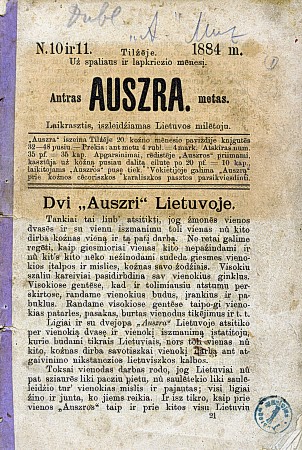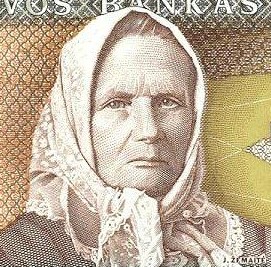|
Twelve Apostles Of Vilnius
The Lithuanian Mutual Aid Society of Vilnius ( lt, Vilniaus lietuviŇ≥ savitarpinńós paŇ°alpos draugija) was a mutual aid and cultural society active in Vilnius, then part of the Russian Empire, from 1904 to 1915. It originated from the illegal social club known as the Twelve Apostles of Vilnius which formed around 1895. The society was an integral part of establishing Vilnius as the cultural center of the Lithuanian National Revival. The club organized Lithuanian cultural evenings and distribution of the illegal Lithuanian publications, but its major accomplishment was obtaining the Church of Saint Nicholas for the needs of the Lithuanian community in Vilnius. Before, there was no church in the city that held masses in Lithuanian. Starting in May 1896, members of the club submitted repeated petitions to various religious and civil authorities until their demands were met in December 1901. The Church of Saint Nicholas remained the only church in the city that provided Lithuanian-l ... [...More Info...] [...Related Items...] OR: [Wikipedia] [Google] [Baidu] |
Mutual Aid Society
A benefit society, fraternal benefit society, fraternal benefit order, friendly society, or mutual aid society is a society, an organization or a voluntary association formed to provide mutual aid, benefit, for instance insurance for relief from sundry difficulties. Such organizations may be formally organized with charters and established customs, or may arise ''ad hoc'' to meet unique needs of a particular time and place. Many major financial institutions existing today, particularly some insurance companies, mutual savings banks, and credit unions, trace their origins back to benefit societies, as can many modern fraternal organizations and fraternal orders which are now viewed as being primarily social. The modern legal system essentially requires all such organizations of appreciable size to incorporate as one of these forms or another to continue to exist on an ongoing basis. Benefit societies may be organized around a shared ethnic background, religion, occupation, geog ... [...More Info...] [...Related Items...] OR: [Wikipedia] [Google] [Baidu] |
Jonas VileiŇ°is
Jonas VileiŇ°is (January 3, 1872 ‚Äď June 1, 1942) was a Lithuanian lawyer, politician, and diplomat. Early life and career VileiŇ°is was born in Mediniai, near Pasvalys. In 1892 he graduated from the ҆iauliai Gymnasium. During 1892-1894, he studied physics and mathematics at Saint Petersburg University. Later he transferred to the study of law, graduating in 1898. As a student he began contributing to the newspapers ''Varpas'' (''The Bell'') and '' Ň™kininkas'' (''The Farmer''). From 1896 to 1898 he was a member of the Social Democratic Party of Lithuania. After returning to Lithuania, he began practicing law and joined the ''12 Apostles'' organization, dedicated to defending the right to use the Lithuanian language in print, which was banned at the time. In 1902 he participated in the creation of the Lithuanian Democratic Party. After the ban on Lithuanian language was lifted in 1904, VileiŇ°is obtained permission to publish the newspaper '' Lietuvos Ň™kininkas'' and was ... [...More Info...] [...Related Items...] OR: [Wikipedia] [Google] [Baidu] |
Vilna Governorate
The Vilna Governorate (1795‚Äď1915; also known as Lithuania-Vilnius Governorate from 1801 until 1840; russian: –í–ł–Ľ–Ķ–Ĺ—Ā–ļ–į—Ź –≥—É–Ī–Ķ—Ä–Ĺ–ł—Ź, ''Vilenskaya guberniya'', lt, Vilniaus gubernija, pl, gubernia wileŇĄska) or Government of Vilnius was a governorate (') of the Russian Empire created after the Third Partition of the Polish‚ÄďLithuanian Commonwealth in 1795. It was part of the Lithuanian General Governorate, which was called the Vilnius General Governorate after 1830, and was attached to the Northwestern Krai. The seat was in Vilnius (Vilna in Russian), where the Governors General resided. History The first governorates, Vilnius Governorate (consisting of eleven uyezds or districts) and Slonim Governorate, were established after the third partition of the Polish-Lithuanian Commonwealth. Just a year later, on December 12, 1796, by order of Tsar Paul I they were merged into one governorate, called the Lithuanian Governorate, with its capital in Vilnius. By orde ... [...More Info...] [...Related Items...] OR: [Wikipedia] [Google] [Baidu] |
AuŇ°ra
''AuŇ°ra'' or ''Auszra'' (literally: ''dawn'') was the first national Lithuanian newspaper. The first issue was published in 1883, in Ragnit, East Prussia, Germany (newspaper credited it as lt, Ragainńó) East Prussia's ethnolinguistic part - Lithuania Minor. Later it was published monthly in Tilsit (present-day Sovetsk). Even though only forty issues were published and the circulation did not exceed 1,000, it was a significant event as it marked the beginnings of the Lithuanian national rebirth that eventually resulted in an independent Lithuanian State (1918‚Äď1940). This period, between 1883 and 1904, when the Lithuanian press ban was enforced by Tsarist authorities, has been referred to as the ''AuŇ°ros gadynńó'' (the Dawn Period). Due to financial difficulties the printing was discontinued in 1886. History After the Russian authorities denied permission to publish a Lithuanian newspaper in Vilnius, Jonas ҆liŇępas proposed to publish it in East Prussia, Germany. Howeve ... [...More Info...] [...Related Items...] OR: [Wikipedia] [Google] [Baidu] |
List Of Churches In Vilnius
List of churches in Vilnius, Lithuania, includes existing places of worship ‚Äď churches, synagogues, kenesas ‚Äď even if they are no longer used for religious purposes. List {, class="wikitable sortable" width=100% , - ! Image , , Name , , Lithuanian name , , Denomination , , Location , - , , , Vilnius Cathedral, Cathedral Basilica of St. Stanislaus and St. Vladislav, Vilnius , , ҆v. Stanislovo ir ҆v. Vladislovo arkikatedra bazilika , , Roman Catholic , , , - , , , Cathedral of the Theotokos, Vilnius , , Dievo Motinos ńĖmimo ńĮ DangŇ≥ katedra , , Eastern Orthodox , , , - , , , Choral Synagogue, Vilnius , , Choralinńó sinagoga , , Judaism , , , - , , , Church of All Saints, Vilnius , , VisŇ≥ ҆ventŇ≥jŇ≥ baŇĺnyńćia , , Roman Catholic (Carmelites) , , , - , , , Church of the Ascension, Vilnius , , VieŇ°paties Dangun ŇĹengimo baŇĺnyńćia , , Roman Catholic (missionaries) , , , - , , , Church of the Assumption of the Blessed Virgin Mary, Vi ... [...More Info...] [...Related Items...] OR: [Wikipedia] [Google] [Baidu] |
Okhrana
The Department for Protecting the Public Security and Order (russian: –ě—ā–ī–Ķ–Ľ–Ķ–Ĺ–ł–Ķ –Ņ–ĺ –ĺ—Ö—Ä–į–Ĺ–Ķ–Ĺ–ł—é –ĺ–Ī—Č–Ķ—Ā—ā–≤–Ķ–Ĺ–Ĺ–ĺ–Ļ –Ī–Ķ–∑–ĺ–Ņ–į—Ā–Ĺ–ĺ—Ā—ā–ł –ł –Ņ–ĺ—Ä—Ź–ī–ļ–į), usually called Guard Department ( rus, –ě—Ö—Ä–į–Ĺ–Ĺ–ĺ–Ķ –ĺ—ā–ī–Ķ–Ľ–Ķ–Ĺ–ł–Ķ, tr= okhrannoye otdelenie) and commonly abbreviated in modern English sources as Okhrana ( rus , –ě—Ö—Ä–į–Ĺ–į, p=…źňąxran…ô, a=Ru-–ĺ—Ö—Ä–į–Ĺ–į.ogg, t= the guard) was a secret-police force of the Russian Empire and part of the police department of the Ministry of Internal Affairs (MVD) in the late 19th century and early 20th century, aided by the Special Corps of Gendarmes. Overview Formed to combat political terrorism and left-wing revolutionary activity, the Okhrana operated offices throughout the Russian Empire, as well as satellite agencies in a number of foreign countries. It concentrated on monitoring the activities of Russian revolutionaries abroad, including in Paris, where the Okhrana agent Pyotr Rachkovsky ... [...More Info...] [...Related Items...] OR: [Wikipedia] [Google] [Baidu] |
Emilija VileiŇ°ienńó
Emilija VileiŇ°ienńó ''n√©e'' Jasmantaitńó (1861‚Äď1935) was a Lithuanian activist. Born to a noble family, she attended the Smolny Institute and lived with her older brother in Saint Petersburg and Caucasus. When her brother became severely ill, they moved to Vilnius (Wilno, Vilna) where VileiŇ°ienńó met her husband Antanas VileiŇ°is and became active in Lithuanian cultural life. She was an active member of various Lithuanian organizations, including the Lithuanian Mutual Relief Society of Vilnius, Society of Saint Zita for servants, cultural RŇęta Society. During World War I, she was a board member of the Lithuanian Society for the Relief of War Sufferers and was particularly active in organizing relief for war refugees. After the war, she remained in Vilnius and continued active public life despite several arrests by the Polish government. In 1928‚Äď1930, she toured numerous Lithuanian American communities collecting donations for the orphans and the poor. Biography Early li ... [...More Info...] [...Related Items...] OR: [Wikipedia] [Google] [Baidu] |
Petras VileiŇ°is
Petras VileiŇ°is (25 January 1851 ‚Äď 12 August 1926) was a prominent Lithuanian engineer specializing in the construction of railroad bridges. He was very active in Lithuanian public life and together with his brothers Jonas and Antanas became one of the key figures of the Lithuanian National Revival. He studied mathematics at St. Petersburg University and railroad construction at the Emperor Alexander I Institute of Transport Engineers. For about two decades, VileiŇ°is designed and constructed various railroad bridges across the Russian Empire amassing a substantial personal fortune. In 1899, he returned to Lithuania and settled in Vilnius where he built VileiŇ°is Palace and established the first Lithuanian-language daily newspaper ''Vilniaus Ňĺinios'' as well as a Lithuanian printing press, bookstore, and ironwork factory which later became Vilija. None of these activities were profitable and by 1908 he had exhausted his savings. He then returned to Russia to work on railway ... [...More Info...] [...Related Items...] OR: [Wikipedia] [Google] [Baidu] |
Felicija Bortkevińćienńó
Felicija Bortkevińćienńó ''n√©e'' Povickaitńó (1 September 1873 ‚Äď 21 October 1945) was a Lithuanian politician and long-term publisher of ''Lietuvos Ňękininkas'' and ''Lietuvos Ňĺinios''. She became active in social life after she moved to Vilnius in 1900 and became known as an energetic and prolific organizer, manager, and treasurer of numerous political, cultural, and charitable organizations. She joined and was one of the leaders of various political parties, including Lithuanian Democratic Party, Peasant Union, and Lithuanian Peasant Popular Union. She was a delegate to the Great Seimas of Vilnius (1905) and was elected to the Constituent Assembly of Lithuania (1920) and was considered for the position of Minister of Provision and Public Work (1918) and President of Lithuania (1926). Bortkevińćienńó organized and ran several charitable organizations, including those supporting gifted students, political prisoners of the Tsarist regime, and deported Prussian Lithuanians. She ... [...More Info...] [...Related Items...] OR: [Wikipedia] [Google] [Baidu] |
Gabrielńó Petkevińćaitńó-Bitńó
Gabrielńó Petkevińćaitńó (; 18 March 1861 ‚Äď 14 June 1943) was a Lithuanian educator, writer, and activist. Her pen name Bitńó (''Bee'') eventually became part of her last name. Encouraged by Povilas ViŇ°inskis, she joined public life and started her writing career in 1890, becoming a prominent member of the Lithuanian National Revival. She was the founder and chair of the ŇĹiburńólis society to provide financial aid to struggling students, one of the editors of the newspaper ''Lietuvos Ňĺinios'', and an active member of the women's movement. In 1920, she was elected to the Constituent Assembly of Lithuania and chaired its first session. Her realist writing centered on exploring the negative impact of the social inequality. Her largest work, two-part novel ''Ad astra'' (1933), depicts the rising Lithuanian National Revival. Together with ŇĹemaitńó, she co-wrote several plays. Her diary, kept during World War I, was published in 1925‚Äď1931 and 2008‚Äď2011. Biography Early lif ... [...More Info...] [...Related Items...] OR: [Wikipedia] [Google] [Baidu] |
ŇĹemaitńó
ŇĹemaitńó (literally ''female Samogitian'') was the pen name of Julija BeniuŇ°evińćiŇętńó-ŇĹymantienńó ( ‚Äď 7 December 1921). She was a Lithuanian/Samogitian writer, democrat and educator. Born to impoverished gentry, she became one of the major participants in the Lithuanian National Revival. She wrote about peasant life in the style best described as realism. Life ŇĹemaitńó was born in a manor house near Plungńó in the Kovno Governorate of the Russian Empire. Her father Antanas BeniuŇ°evińćius (died 1878) served as a manor steward and her mother Julijana Sciepuraitńó (died 1874) was a housekeeper. ŇĹemaitńó had three sisters. As a child, she was forbidden by her parents to play with the children of serfs or learn the Lithuanian language. Like many of the Lithuanian gentry, her parents had become Polonized, and were of the belief that speaking Lithuanian was a step backward socially. Nevertheless, she did learn the language and gained a deep affection for the common people. ... [...More Info...] [...Related Items...] OR: [Wikipedia] [Google] [Baidu] |






.jpeg)

